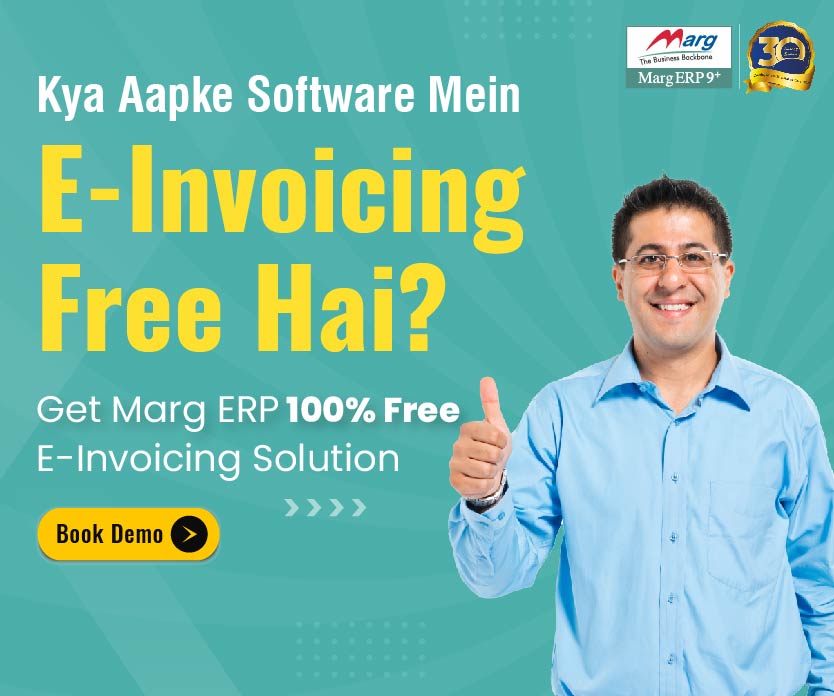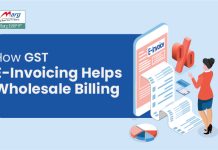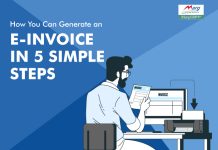Recent Updates on e-Invoicing:
10th May 2023
The Central Board of Indirect Taxes and Customs (CBIC) has introduced the 6th phase of e-invoicing to support the government’s goals of promoting a paperless GST system, simplifying business compliance costs, and improving the efficiency of the GST system. From August 1st, 2023, companies with an annual turnover of ?5 crore or more since 2017-18 will be required to generate e-invoices. This measure aims to facilitate a seamless shift towards digitization and alleviate the manual paperwork burden on businesses.
Introduction:
In today’s fast-paced business landscape, digital transformation has become crucial for organizations to stay competitive and enhance operational efficiency. One area that has witnessed significant advancements is invoicing. Traditional paper-based invoices are being replaced by electronic invoicing, also known as e-invoicing. This blog explores the benefits and features of e-invoicing software in Jharkhand, helping businesses streamline their invoicing processes and adapt to the digital era.
Understanding E-Invoicing:
What is E-Invoicing?
Electronic Invoicing, or e-invoicing, is the process of creating, sending, receiving, and managing invoices electronically. It replaces traditional paper-based invoices with digital formats, allowing businesses to automate their invoicing workflows and eliminate manual processes.
The Legal Framework in Jharkhand:
In Jharkhand, e-invoicing is governed by the Goods and Services Tax (GST) laws and regulations. The implementation of e-invoicing is aligned with the national e-invoicing framework introduced by the Government of India. Businesses in Jharkhand must comply with these regulations and adopt e-invoicing for their transactions.
Key Components of E-Invoicing:
E-invoicing consists of several essential components, including:
a) Invoice Generation: Businesses create invoices digitally using e-invoicing software, ensuring accuracy and consistency in invoice data.
b) Invoice Transmission: Electronic invoices are securely transmitted to buyers and tax authorities through standardized protocols.
c) Invoice Validation: The e-invoicing system validates the invoices against specified parameters, ensuring compliance with the GST regulations.
d) Invoice Reporting: Relevant invoice data is reported to the GST portal, enabling real-time visibility for tax authorities.
Benefits of E-Invoicing Software:
Improved Accuracy and Efficiency: By automating the invoicing process, e-invoicing software minimizes errors associated with manual data entry and calculations, resulting in increased accuracy. It also reduces the time and effort required to create, process, and reconcile invoices.
Cost and Time Savings: E-invoicing eliminates the need for paper-based invoices, reducing printing, postage, and storage costs. Additionally, automated workflows and faster payment cycles result in time savings for both businesses and their customers.
Enhanced Data Security and Compliance: E-invoicing software ensures secure transmission and storage of invoice data, protecting it from loss, damage, or unauthorized access. The system also facilitates compliance with GST regulations by validating invoice data and generating reports for tax authorities.
Real-Time Tracking and Visibility: With e-invoicing, businesses can track the status of invoices in real-time. They can monitor when an invoice is sent, received, and paid, improving transparency and visibility into the invoicing process.
Reduction in Environmental Footprint: By eliminating paper-based invoices, businesses contribute to environmental sustainability by reducing paper consumption and waste. E-invoicing aligns with eco-friendly practices and promotes a paperless office environment.
Features to Look for in E-Invoicing Software:
Automated Invoicing and Workflow: Efficient e-invoicing software automates invoice generation, approval workflows, and payment processes, reducing manual intervention and accelerating the entire invoicing cycle.
Integration Capabilities: The software should seamlessly integrate with existing accounting, ERP, or CRM systems to ensure smooth data exchange and avoid duplications.
Multi-channel Invoicing: A robust e-invoicing solution supports various channels for invoice delivery, including email, online portals, and mobile applications, catering to the diverse preferences of customers.
Customization and Branding: Businesses should look for software that allows customization of invoice templates, enabling them to reflect their brand identity and maintain a professional appearance.
Analytics and Reporting: E-invoicing software equipped with advanced analytics and reporting features provides valuable insights into invoicing patterns, payment trends, and outstanding dues, aiding in financial analysis and decision-making.
Implementing E-Invoicing in Jharkhand:
Ensuring Compliance with GST Regulations: Businesses must understand and comply with the e-invoicing guidelines set by the GST authorities in Jharkhand. This includes adhering to invoice format requirements, invoice registration processes, and reporting obligations.
Collaboration with Tax Authorities and Service Providers: Collaboration with tax authorities and partnering with authorized e-invoicing service providers is essential for successful implementation. These stakeholders can provide guidance, technical support, and facilitate a smooth transition.
Preparing for E-Invoicing Implementation:Businesses should assess their existing invoicing processes, identify potential gaps, and prepare a roadmap for e-invoicing adoption. This includes evaluating their IT infrastructure, training employees, and updating internal processes.
Training and Support for Staff: Employees should receive proper training on using the e-invoicing software, understanding the new invoicing workflow, and complying with GST regulations. Ongoing support should be provided to address any queries or issues that arise during the implementation phase.
Transitioning from Manual to Electronic Processes: Moving from manual invoicing to e-invoicing requires a phased approach. Businesses may need to convert their existing paper-based invoices into digital formats, update their accounting systems, and ensure a smooth transition without disruption to their operations.
Choosing the Right E-Invoicing Software:
Assessing Business Requirements: Before selecting an e-invoicing software solution, businesses should evaluate their specific invoicing needs, such as transaction volume, integration requirements, scalability, and budget constraints.
Scalability and Flexibility: The software should be scalable to accommodate the growing invoicing needs of the business. It should also be flexible enough to adapt to changing business requirements and future technological advancements.
User-Friendly Interface: An intuitive and user-friendly interface simplifies the invoice creation, management, and tracking processes. Businesses should prioritize software solutions that offer an easy-to-use interface for enhanced user experience.
Integration with Existing Systems: Seamless integration with existing accounting, ERP, or CRM systems eliminates manual data entry and facilitates streamlined data exchange, ensuring data accuracy and consistency across all systems.
Security and Data Privacy Measures: Choosing an e-invoicing software that prioritizes data security and privacy is crucial. Look for features such as encryption, access controls, data backups, and compliance with data protection regulations to safeguard sensitive invoice information.
E-Invoicing Adoption Challenges:
Resistance to Change: Transitioning from traditional invoicing methods to e-invoicing may face resistance from employees who are accustomed to manual processes. Organizations should provide proper training, communicate the benefits, and address concerns to overcome resistance.
Lack of Awareness and Education: Many businesses in Jharkhand may lack awareness and understanding of the benefits and implementation processes of e-invoicing. Government initiatives, awareness campaigns, and educational resources can help bridge this knowledge gap.
Technical Infrastructure Requirements: Effective implementation of e-invoicing requires robust technical infrastructure, including stable internet connectivity, adequate hardware, and software resources. Businesses may need to invest in upgrading their infrastructure to support e-invoicing processes.
Addressing Language and Regional Considerations: In Jharkhand, where multiple languages are spoken, e-invoicing software should support regional language capabilities to cater to the needs of businesses operating in diverse linguistic regions.
Overcoming Connectivity Issues: Reliable and uninterrupted internet connectivity is crucial for successful e-invoicing implementation. In regions with limited connectivity, businesses should explore alternative connectivity options or offline modes of data submission.
Free Download E-invoicing Software
Conclusion:
E-invoicing software offers tremendous benefits for businesses in Jharkhand, streamlining invoicing processes, reducing costs, improving accuracy, and enhancing compliance. By embracing e-invoicing and selecting the right software solution, businesses can adapt to the digital era, gain a competitive edge, and contribute to a more efficient and sustainable business environment in Jharkhand.
Read More Useful Content:
Frequently Asked Questions (FAQs)
Q: What is e-invoicing?
A: E-invoicing refers to the electronic generation, transmission, and processing of invoices digitally, replacing traditional paper-based invoices.
Q: Is e-invoicing mandatory for businesses in Jharkhand?
A: Yes, e-invoicing is mandatory for businesses in Jharkhand as per the Goods and Services Tax (GST) regulations. It applies to businesses with an annual turnover above a specified threshold.
Q: How does e-invoicing benefit businesses in Jharkhand?
A: E-invoicing offers benefits such as improved accuracy, time and cost savings, enhanced compliance, real-time tracking, and reduced environmental impact.
Q: What are the technical requirements for implementing e-invoicing?
A: To implement e-invoicing, businesses need a stable internet connection, compatible software or platforms, and appropriate hardware infrastructure such as computers or mobile devices.
Q: Can e-invoicing software integrate with existing accounting or ERP systems?
A: Yes, reputable e-invoicing software solutions provide integration capabilities, allowing seamless integration with existing accounting, ERP, or CRM systems, ensuring data consistency and streamlined workflows.
Q: How can businesses ensure compliance with GST regulations while using e-invoicing software?
A: Businesses must ensure that the e-invoicing software they choose adheres to the GST guidelines and supports the required invoice formats and reporting obligations as per the regulations.
Q: Is e-invoicing secure, and what measures are in place to protect data privacy?
A: E-invoicing software employs robust security measures such as encryption, access controls, data backups, and compliance with data protection regulations to ensure the security and privacy of invoice data.
Q: What challenges can businesses face during the transition to e-invoicing?
A: Challenges during the transition to e-invoicing may include resistance to change, lack of awareness and education, technical infrastructure requirements, language considerations, and connectivity issues in remote areas.
Q: Can e-invoicing software support regional languages spoken in Jharkhand?
A: Yes, some e-invoicing software solutions offer regional language capabilities, allowing businesses in Jharkhand to generate invoices in languages commonly spoken in the region.
Q: How can businesses choose the right e-invoicing software for their needs?
A: Businesses should consider factors such as their specific requirements, scalability, integration capabilities, user-friendliness, security measures, and compliance with GST regulations when selecting e-invoicing software.






